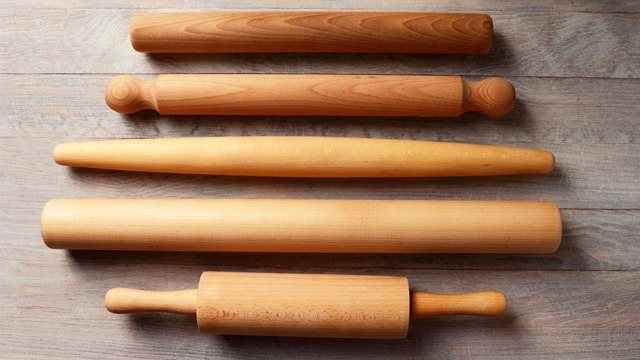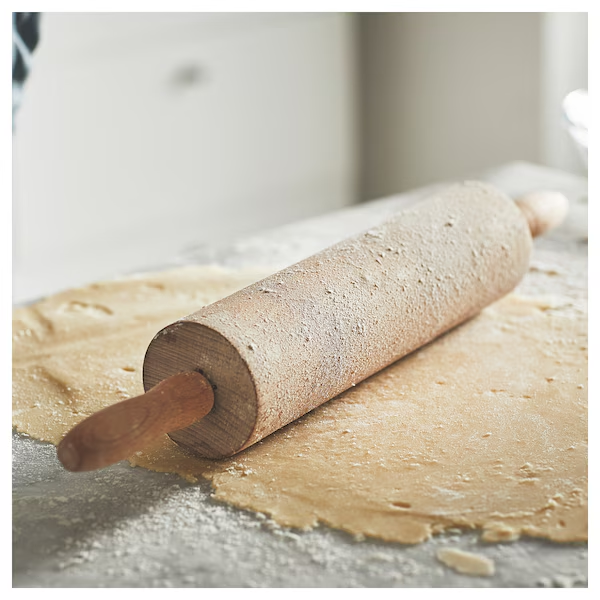A rolling pin may seem simple, but this humble tool has a fascinating history that dates back centuries. Originating in ancient Etruscan society around the 9th century, the first rolling pins were crafted from wood, clay, stone, and even glass. These early designs served the same purpose as today’s pins: flattening and shaping dough for a variety of baked goods. Over time, the Greeks and Romans adopted the rolling pin, spreading its use throughout Europe and eventually the world.
The rolling pin continued to evolve, and in the 19th century, J.W. Reed, an American inventor, created the first rolling pin with handles. This improvement allowed bakers to roll dough more precisely without touching it directly, keeping their hands clean and making the tool easier to use. Today, rolling pins come in many designs and materials, each suited to different baking needs, making it a true kitchen essential.
Types of Rolling Pins for Every Baking Task

When it comes to rolling pins, there’s no one-size-fits-all. Choosing the right type can make a big difference in your baking results. Here are the three main categories of rolling pins and their ideal uses:
- Rod Rolling Pins: These are thin, handle-free pins popular in French and Asian cooking. Rod rolling pins allow for precise control and are perfect for pastry work or delicate doughs that require a light touch, such as pie crusts or dumpling wrappers. Some rod pins have tapered ends, making it easier to roll dough evenly.
- Roller Rolling Pins: Known as the classic Western-style pin, this type features a thick roller with two handles, making it easier for beginners to use. Roller pins provide stability and even pressure, ideal for tasks like rolling out cookie dough, pizza crusts, or larger batches of pastry.
- Textured Rolling Pins: These specialty pins have raised patterns on their surface and are used to emboss decorative designs into dough. Perfect for cookies, pie crusts, and pasta, textured pins add intricate details to baked goods, making them visually stunning with minimal effort.
Choosing the Best Material for Your Rolling Pin
The material of your rolling pin can greatly impact its performance and durability. Here’s a look at the most common materials and what they offer:
- Wooden Rolling Pins: Classic and versatile, wooden pins are gentle on dough and naturally non-stick. Maple, beech, and cherry wood are popular choices, known for their durability and smooth finish. However, wooden pins can absorb moisture and odors, so cleaning them promptly is essential to prevent damage.
- Marble Rolling Pins: Heavy and cool to the touch, marble rolling pins are ideal for doughs that need to stay cold, such as puff pastry. The coolness of the marble keeps the butter in the dough firm, ensuring a flakier texture. These pins are heavier, which some bakers find helpful, though they can be more fragile if dropped.
- Stainless Steel Rolling Pins: Sleek, durable, and lightweight, stainless steel pins are a modern favorite. They don’t absorb flavors or odors, making them versatile, and they’re easy to clean. Stainless steel doesn’t retain cold like marble, but it’s cool enough for most tasks and ideal for dough that requires a non-stick surface.
- Silicone and Plastic Rolling Pins: Lightweight and often non-stick, silicone and plastic pins are beginner-friendly and work well with sticky doughs like those for sugar cookies. They’re easy to clean and less prone to damage, though they may lack the weight needed for tougher doughs.
Rolling Pin Designs Around the World

Rolling pins are an integral part of kitchens worldwide, with regional variations that reflect local baking traditions and techniques. Here are a few popular cultural styles:
- French Rolling Pin: A rod-style pin with tapered ends, popular in France for pastry-making. It allows bakers to roll out dough using a gentle, even pressure, ideal for delicate doughs.
- Belan and Chakla: In Indian cuisine, the belan (rolling pin) is paired with a chakla (flat circular board) to make chapatis, rotis, and other flatbreads. This setup provides a stable base for rolling very thin dough.
- Oklava: A thin, tapered rolling pin used in Turkish cooking, specifically for making yufka, a thin dough used in baklava and other pastries. The oklava’s design makes it easier to roll dough paper-thin.
Mastering Techniques for Rolling Dough
Using a rolling pin effectively takes practice and technique. Here are a few essential tips to help you make the most of this tool:
- Chill the Dough: Cold dough, especially for pie crusts, is less sticky and easier to work with. A chilled marble or stainless steel rolling pin can help keep the dough cool, preventing the butter from melting and ensuring a flaky texture.
- Apply Light, Even Pressure: Press down gently to avoid overworking the dough, which can make it tough. Place your hands towards the ends of the rolling pin, and keep your pressure steady.
- Rotate the Dough: Instead of lifting the rolling pin frequently, rotate the dough every quarter turn to ensure an even thickness. This is particularly important for circular shapes, like pie crusts and tart shells.
- Use Flour Sparingly: Too much flour can dry out the dough, so use it sparingly. Lightly dust both the surface and the rolling pin, adding more flour only if necessary.
Caring for Your Rolling Pin

Taking care of your rolling pin will ensure it lasts for years to come. Here’s how to keep it in top shape:
- Clean with Care: For wooden pins, avoid soaking them in water, as this can cause cracking. Wipe them with a damp cloth and dry immediately. Silicone and stainless steel pins can be washed with mild soap and water.
- Season with Oil: Occasionally, apply food-safe mineral oil to wooden pins to prevent them from drying out and cracking. This is especially important for hardwood pins, which can dry and warp over time.
- Store Properly: Keep your rolling pin in a cool, dry place. Wooden pins, in particular, should be stored away from direct sunlight or humidity to prevent warping.
Why Every Kitchen Needs a Rolling Pin
Rolling pins aren’t just for serious bakers—they’re a staple in any kitchen. Whether you’re a beginner making cookies or a professional creating intricate pastries, having the right rolling pin can make a noticeable difference in your results. From rolling out pizza dough for a family dinner to crafting the perfect pie crust for a special occasion, a quality rolling pin is as essential as a sharp knife or a sturdy pan.
Conclusion: The Timeless Appeal of Rolling Pins
The rolling pin is a classic tool that has been a mainstay in kitchens around the world for centuries. With its simple design and impressive versatility, it adapts to a wide range of baking tasks. By choosing the right type and material, and mastering a few basic techniques, you can elevate your baking skills and make dough preparation more enjoyable and efficient.
Whether you choose a traditional wooden rod, a durable stainless steel pin, or a decorative textured pin, investing in a quality rolling pin can enhance every dough-based recipe you try. The beauty of a rolling pin lies in its simplicity and effectiveness, proving that sometimes the most timeless tools truly are the best.


